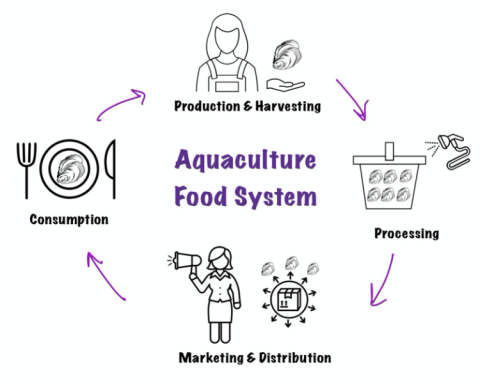This research was published in the INSPIRED: A Publication of the New Hampshire Agricultural Experiment Station (Fall 2024)
Researchers: N. Lord and E. R. White
The diversity of industries and sectors within the seafood economy presents a challenge for understanding the demographics of those that work in the sector. Current approaches to characterizing the sector's demographics use coarse estimates of the number of workers and average wages. Even in New Hampshire's fastest-growing seafood sector—oyster aquaculture—there are no demographic estimates across its supply chain. As the aquaculture industry in New Hampshire continues to expand, understanding the demographics of those involved is key to developing policies and best practices that ensure an equitable and just seafood system as well as understanding industry barriers and opportunities to enable the industry to maximize its economic and ecosystem benefits for the state and region.
Background and Key Concepts
Opportunity exists for new policies and industry best practices to ensure social equity within the seafood sector. New Hampshire's and the Northeast's seafood industry is growing and reaching a pivotal point for development, yet minimal research and decision-making has incorporated all dimensions of sustainability (ecological, social, and economic), instead focusing primarily on ecological factors to enhance production and increase market value.
Investigating aquaculture development through a social lens provides an opportunity to understand how wild capture fisheries and aquaculture can sustainably co-exist in the Gulf of Maine, as there is a need for both to address growing seafood demand.
There is a growing body of social science research on the domestic seafood sector covering topics such as perceptions of aquaculture, livelihood diversification, and gender equity. However, research has lacked an intersectional approach due to deficiencies in demographic variables such as gender, race/ethnicity, and income as a baseline of information.
Key Findings
- Demographic data are key for ensuring social and economic sustainability in New England's aquaculture sector.
- The existence of gender inequity in the aquaculture sector is perceived differently by current aquaculture producers, with nearly 50% of women and nonbinary respondents reporting gender discrimination.
- Women oyster farmers participate in the full production and marketing cycle as a means to avoid or minimize gendered outcomes.
About the Co-author

Easton White, Assistant Professor of Biological Sciences
Contact information: Easton.White@unh.edu, FindScholars profile

Fig. 1. Researchers found that participants in this study engaged in all sectors of the food system as oyster farm owners.
Methodology
New England supports the largest network of women aquaculturists in the country. As such, data collection focused on identifying the role of gender for the oyster aquaculture workforce in Maine and New Hampshire, which would help fill the demographic information gap and highlight unique challenges of women and nonbinary farmers. These data could help identify barriers to entry for underrepresented groups aspiring to enter the aquaculture workforce.
The research also included a participatory methodology called photovoice, which incorporates visual storytelling with interviews, a focus group, and a community photo exhibit. The case studies provided deeper insight into the potential sources of gender discrimination amongst participants.
Discussion of Findings
The research findings helped establish baseline demographic data and determine how gender influences participation in aquaculture. In contrast to other seafood systems, women oyster farmers engage in all parts of the product's food system as a means to avoid gendered outcomes. Approximately half (46%) of the women and nonbinary survey respondents have experienced differential treatment while working on an oyster farm (Fig. 1).

Fig. 2. Survey respondents reporting differential treatment at work in the oyster aquaculture industry in ME and NH by gender. Women and non-binary identifying (n=13), men identifying (n=26). Relationship between gender and differential treatment is statistically significant (p<0.001).
Approximately half (46%) of the women and nonbinary survey respondents have experienced differential treatment while working on an oyster farm (Fig. 2). These results indicate the women and nonbinary participants likely have additional barriers for launching and operating oyster aquaculture farms than their male counterparts. Barriers include access to funding, relevant training programs, appropriate farm gear and equipment and overcoming gender norms of the maritime industry.
Strategic Recommendations and Conclusion
These findings help inform efforts to overcome such barriers. For example, women-led social networks may be needed to overcome gender-based barriers that exist in aquaculture systems, which may historically lack support due to gender-blind policies and programming. Such efforts have been previously successful—in summer 2024, a women and nonbinary-targeted aquaculture training program was developed by Maine Sea Grant and an industry-led women and gender nonconforming networking group of the Maine Aquaculture Innovation Center.
The gap in baseline demographic data identified by this research in New England's seafood sector also provides information that can be leveraged by federal and state agencies, many of which are putting an emphasis on programs, policies, and rule-setting that increases equity and environmental justice. To further strengthen evidence-based needs assessments, collection of demographic information alongside commercial fisheries and aquaculture permits is an achievable first step.
Beyond new training and network opportunities, other recommendations include alternative funding mechanisms such as microloans for aquaculture entrepreneurship and reduced licensing fees for socially disadvantaged and underserved groups to remove barriers to entry into the aquaculture workforce.
Future research could help expand demographic characterization of the aquaculture workforce in New England to include commercial fisheries and the recreational fishing sector, helping identify barriers to participation and reflect the diversity of the broader seafood workforce in the region. Insights from these data could help inform workforce development programs that lower barriers to entry for those seeking employment in the seafood sector.
When combined with knowledge from research that assesses challenges across different New England communities to access and consume local seafood products, the findings can be critical for developing markets and policies that promote sustainable working conditions, compensation, access to resources that might be different for diverse demographic groups, and strengthening the resiliency of regional food systems.
This material is based on work supported by the NH Agricultural Experiment Station through joint funding from the USDA National Institute of Food and Agriculture (under Hatch award number 7005066) and the state of New Hampshire.

